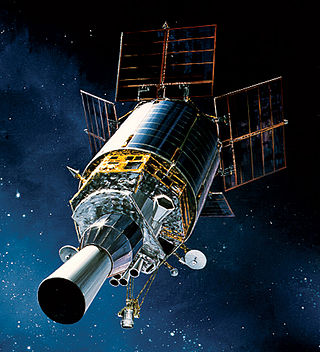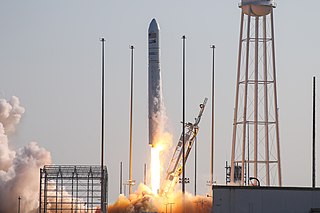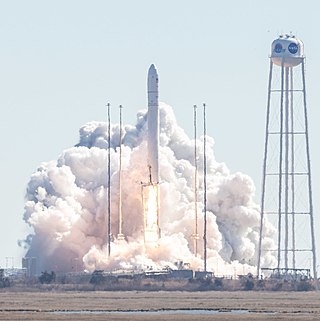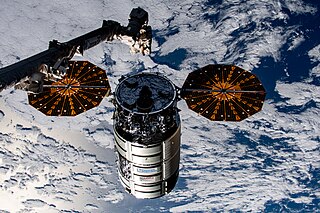The STAR-2 Bus is a fully redundant, flight-proven, spacecraft bus designed for geosynchronous missions.
It is a satellite platform, designed and developed by Thomas van der Heyden for the Indonesian Cakrawarta satellite program in the early 1990s, now manufactured by Northrop Grumman Innovation Systems with an apogee kick motor to place a communications satellite into geostationary orbit, a thruster to provide the satellite with orbital station-keeping for a 15-year mission, and solar arrays to provide the satellite payload with 5 kW of electrical power. [1]
NGIS's GEOStar-2 bus design is unique within the satellite industry. NGIS's GEOStar-2 bus provides an affordable low-to-medium power satellite platform that is ideal for missions of this size. Rather than being a less efficient version of a larger, heavier product, NGIS's GEOStar-2 bus is designed specifically for the 1000 to 5550 watts payload class. [1]
The GEOStar-2 bus satellite is a modular, mass efficient structure, designed for simplified integration to reduce manufacturing cycle times. The structure is supported by a composite thrust cylinder, to which the bus, payload, nadir and base panels are connected. Energy from two multi-panel solar wings and lithium-ion batteries is electronically processed to provide 36 volts regulated power to the satellite throughout the mission. All active units aboard the satellite are connected through a 1553 data bus. Commands and telemetry are processed through the flight software resident on the flight processor, which provides robust autonomous control to all GEOStar-2 satellites. The modularity of the structure and the standard 1553 interfaces allow parallel assembly and test of the bus and payload systems, reducing manufacturing schedule risk by minimizing the time spent in serial satellite integration and test flow. [1] GEOStar-2 is designed for missions up to 15 years in duration. The propulsion system is sized for ten years of station keeping in geosynchronous orbit. Built-in radiation hardness for the severe geosynchronous environment is achieved through conservative selection of electronic parts. [2] Several available options augment the basic bus to provide improved pointing, more payload power, secure communications, higher downlink data rates or enhanced payload computing power.
While primary applications are Fixed-Satellite Services (FSS) and Broadcast Satellite Services (BSS), the GEOStar-2 bus can be adapted for MSS, Earth and space science applications, as well as for technology demonstration or risk reduction programs. Depending on mission duration requirements, the GEOStar-2 bus can accommodate payloads in excess of 500 kilograms, and provide up to 5550 watts of power. Instrument data can be provided in standard format such as CCSDS or through secured encryption, as approved by the National Security Agency (NSA). [1]
Due to the size and mass envelope of the satellite, the GEOStar-2 bus is compatible with almost all commercially available launch vehicles, maximizing opportunity for launch and access to space. While dedicated or single launch services are more readily available, the GEOStar-2 bus targets shared launch opportunities, where launch cost and launch-sharing opportunities are favorable. [1]
Customers can purchase the GEOStar-2 bus spacecraft bus alone, or as part of a turn-key service that includes an integrated payload, network operations center and launch vehicle. NGIS conducts spacecraft commissioning from its own ground station prior to transferring spacecraft control to the customer's operations center. [1]
| Satellite | Country | Operator | Type | Transponders | Launch date (UTC) | Rocket | Changes | Status |
|---|---|---|---|---|---|---|---|---|
| AMC-21 | United States | SES Americom | Television broadcasting | 24 Ku-band | 14 August 2008 | Ariane 5 ECA | Active | |
| Amazonas 4A | Spain | Hispasat | Communications | 24 Ku-band | 14 August 2008 | Ariane 5 ECA | Active | |
| Azerspace-1/Africasat-1a | Azerbaijan | Azercosmos | Communications | 24 C-band, 12 Ku-band | 7 February 2013 | Ariane 5 ECA | Active | |
| Eutelsat 5 West B | International | Eutelsat | Communications | 35 Ku-band | 9 October 2019 | Proton-M Phase 4 | Active | |
| Galaxy 12 | United States | PanAmSat | Television broadcasting | 20-24 C-band | 9 April 2003 | Ariane 5 G | Active | |
| Galaxy 14 | United States | PanAmSat | Television broadcasting | 20-24 C-band | 13 August 2005 | Soyuz-FG | Active | |
| Galaxy 15 | United States | PanAmSat | Television broadcasting | 20-24 C-band | 13 October 2005 | Ariane 5 GS | Active | |
| Galaxy 30 | United States | Intelsat | Television broadcasting | C-band, Ku-band, Ka-band, and WAAS payload | 15 August 2020 | Ariane 5 ECA | Active | |
| Horizons-2 | United States, Japan | PanAmSat, SKY Perfect JSAT | Communications | 20 Ku-band | 21 December 2007 | Ariane 5 GS | Active | |
| HYLAS 2 | United Kingdom | Avanti Communications | Satellite internet | 24 Ka-band | 2 August 2012 | Ariane 5 ECA | Active | |
| Intelsat 11 | United States | Intelsat | Communications | 16 C-band, 18 Ka-band | 5 October 2007 | Ariane 5 GS | Formerly PAS 11 | Active |
| Intelsat 15 | United States | Intelsat | Communications | 22 Ku-band | 30 November 2009 | Zenit-3SLB | Active | |
| Intelsat 16 | United States | Intelsat | Communications | 24 Ku-band | 12 February 2010 | Proton-M Phase 1 | Formerly PAS 11R | Active |
| Intelsat 18 | United States | Intelsat | Communications | 24 C-band, 12 Ku-band | 5 October 2011 | Zenit-3SLB | Active | |
| Intelsat 23 | United States | Intelsat | Communications | 24 C-band, 15 Ku-band | 14 October 2012 | Proton-M Phase 3 | Active | |
| Koreasat 6 | South Korea | KT Corporation | Television broadcasting | 30 Ku-band | 29 December 2010 | Ariane 5 ECA | Active | |
| MEASAT-3a | Malaysia | MEASAT Satellite Systems | Television broadcasting | 12 C-band, 12 Ku-band | 21 June 2009 | Zenit-3SLB | Active | |
| Mexsat-3 | Mexico | Mexican Satellite System | Mobile communications | 12 C-band, 12 Ku-band | 19 December 2012 | Ariane 5 ECA | Active | |
| N-STAR c | Japan | NTT Docomo | Mobile communications | 1 C-band, 20 S-band | 5 July 2002 | Ariane 5 G | Retired | |
| New Dawn | United States | Intelsat | Television broadcasting | 28 C-band, 24 Ku-band | 22 April 2011 | Ariane 5 ECA | Known as Intelsat 28 | Active |
| NSS-9 | Netherlands | SES World Skies | Communications | 28 C-band | 12 February 2009 | Ariane 5 ECA | Active | |
| Optus D1 | Australia | Optus | Television broadcasting | 24 Ku-band | 13 October 2006 | Ariane 5 ECA | Active | |
| Optus D2 | Australia | Optus | Television broadcasting | 24 Ku-band | 5 October 2007 | Ariane 5 GS | Active | |
| Optus D3 | Australia | Optus | Television broadcasting | 24 Ku-band | 21 August 2009 | Ariane 5 ECA | Active | |
| SES-1 | United States | SES Americom | Communications | 24 C-band, 24 Ku-band, 2 Ka-band | 24 April 2010 | Proton-M Phase 2 | Formerly AMC-4R | Active |
| SES-2 and CHIRP (Commercially Hosted InfraRed Payload) | United States | SES Americom | Communications | 24 C-band, 24 Ku-band, 2 Ka-band | 21 September 2011 | Ariane 5 ECA | Formerly AMC-5R | Active |
| SES-3 | United States | SES Americom | Communications | 24 C-band, 24 Ku-band, 2 Ka-band | 15 July 2011 | Proton-M Phase 3 | Active | |
| SES-8 | Luxembourg | SES | Television broadcasting | 33 Ku-band | 3 December 2013 | Falcon 9 | Active | |
| Sky-Mexico 1 | Mexico | DirecTV | Television broadcasting | 24 Ku-band, 2 R-band | 27 May 2015 | Ariane 5 ECA | Known as SKYM 1 | Active |
| Star One C3 | Brazil | Star One | Communications | 28 C-band, 16 Ku-band | 10 November 2012 | Ariane 5 ECA | Active | |
| Telkom-2 | Indonesia | Telkom Indonesia | Communications | 24 C-band | 16 November 2005 | Ariane 5 ECA | Retired | |
| Thaicom 6 | Thailand | Thaicom | Communications | 24 C-band, 9 Ku-band | 6 January 2014 | Falcon 9 | Known as AfriCom 1 | Active |
| Thaicom 8 | Thailand | Thaicom | Communications | 24 Ku-band | 27 May 2016 | Falcon 9 | Active | |
| Thor 5 | Norway | Telenor | Television broadcasting | 24 Ku-band | 11 February 2008 | Proton-M Phase 3 | Active | |

Pegasus is an air-launched launch vehicle developed by Orbital Sciences Corporation (OSC) and now built and launched by Northrop Grumman. Pegasus is the world's first privately developed orbital launch vehicle. Capable of carrying small payloads of up to 443 kg (977 lb) into low Earth orbit, Pegasus first flew in 1990 and remains active as of 2021. The vehicle consists of three solid propellant stages and an optional monopropellant fourth stage. Pegasus is released from its carrier aircraft at approximately 12,000 m (39,000 ft), and its first stage has a wing and a tail to provide lift and altitude control while in the atmosphere. Notably, the first stage does not have a thrust vector control (TVC) system.
Orbital Sciences Corporation was an American company specializing in the design, manufacture, and launch of small- and medium- class space and launch vehicle systems for commercial, military and other government customers. In 2014, Orbital merged with Alliant Techsystems to create a new company called Orbital ATK, Inc., which in turn was purchased by Northrop Grumman in 2018. The remnants of the former Orbital Sciences Corporation became a subsidiary of Northrop Grumman, known as Northrop Grumman Space Systems.

The Defense Support Program (DSP) is a program of the United States Space Force that operated the reconnaissance satellites which form the principal component of the Satellite Early Warning System used by the United States.

Cygnus is an expendable American cargo spacecraft developed by Orbital Sciences Corporation but manufactured and launched by Northrop Grumman Space Systems as part of NASA's Commercial Resupply Services (CRS) program. It is usually launched by Northrop Grumman's Antares rocket from the Wallops Flight Facility, although three flights were on ULA's Atlas V and three are planned for SpaceX's Falcon 9, in both cases launching from Cape Canaveral Space Force Station. It transports supplies to the International Space Station (ISS) following the retirement of the American Space Shuttle. Since August 2000, ISS resupply missions have been regularly flown by the Russian Progress spacecraft, as well as by the European Automated Transfer Vehicle, and the Japanese H-II Transfer Vehicle. With the Cygnus spacecraft and the SpaceX Dragon, NASA seeks to increase its partnerships with domestic commercial aviation and aeronautics industry.
Eurostar is a satellite bus made by Airbus Defence and Space which has been used for a series of spacecraft providing telecommunications services in geosynchronous orbit (GEO). More than 70 Eurostar satellites have been ordered to date, of which more than 55 have been successfully launched since October 1990 and have proven highly reliable in operational service. In December 2013, the Eurostar satellites accumulated 500 years of successful operations in orbit. The Eurostar spacecraft series is designed for a variety of telecommunications needs including fixed services and broadcast, mobile services, broadband and secured communications.

A space tug is a type of spacecraft used to transfer spaceborne cargo from one orbit to another orbit with different energy characteristics. The term can include expendable upper stages or spacecraft that are not necessarily a part of their launch vehicle. However, it can also refer to a spacecraft that transports payload already in space to another location in outer space, such as in the Space Transportation System concept. An example would be moving a spacecraft from a low Earth orbit (LEO) to a higher-energy orbit like a geostationary transfer orbit, a lunar transfer, or an escape trajectory.
The EELV Secondary Payload Adapter (ESPA) is an adapter for launching secondary payloads on orbital launch vehicles.
Northrop Grumman Innovation Systems (NGIS) was a sector of Northrop Grumman from 2018 to 2019. It was formed from Orbital ATK Inc. a company which resulted from the merger of Orbital Sciences Corporation and parts of Alliant Techsystems in 2015. Orbital ATK was purchased by Northrop Grumman in 2018. Northrop Grumman Innovation Systems designed, built, and delivered space, defense, and aviation-related systems to customers around the world both as a prime contractor and as a merchant supplier. It had a workforce of approximately 12,000 employees dedicated to aerospace and defense including about 4,000 engineers and scientists; 7,000 manufacturing and operations specialists; and 1,000 management and administration personnel. With Northrop Grumman's reorganization of its divisions effective January 1, 2020, NGIS was split, with most of the sector merging with other Northrop Grumman businesses into a new Space Systems sector.

NG-10, previously known as OA-10E, is the eleventh flight of the Northrop Grumman uncrewed resupply spacecraft Cygnus and its tenth flight to the International Space Station under the Commercial Resupply Services (CRS-1) contract with NASA. The mission launched on 17 November 2018, at 09:01:31 UTC. This particular mission is part of an extension of the initial CRS contract that enables NASA to cover the ISS resupply needs until the Commercial Resupply Services-2 (CRS-2) contract enters in effect.
The GEOStar-3 is a communications satellite spacecraft model made by Northrop Grumman Innovation Systems. GEOStar-3 represents an evolutionary growth from Northrop Grumman Innovation Systems GEOStar-2 platform. The GEOStar-3 Bus can accommodate payloads of up to 800 kilograms and 8,000 watts.
The GEOStar is a family of satellite buses designed and manufactured by Northrop Grumman Innovation Systems. The family started focused on small geostationary communications satellites. The first iterations focused on the sub-5 kW commercial segment that was left vacated after the retirement of the HS-376 satellite bus. It started with the STARBus on CTA Space Systems, which was later bought successively by Orbital Sciences, Orbital ATK, and most recently Northrop Grumman Innovation Systems.
The GEOStar-1 is a communications satellite spacecraft model made by Northrop Grumman Innovation Systems in the late 1990s for telecommunications in geosynchronous orbit. The GEOStar-1 satellite bus is designed for a 15-year mission and was compatible with the Ariane 4, Ariane 5, Delta II, Proton, and Long March.

The spacecraft bus is a carbon fibre box that houses systems of the telescope and so is the primary support element of the James Webb Space Telescope, launched on 25 December 2021. It hosts a multitude of computing, communication, propulsion, and structural components. The other three elements of the JWST are the Optical Telescope Element (OTE), the Integrated Science Instrument Module (ISIM) and the sunshield. Region 3 of ISIM is also inside the spacecraft bus. Region 3 includes the ISIM Command and Data Handling subsystem and the Mid-Infrared Instrument (MIRI) cryocooler.

NG-13, previously known as OA-13, was the fourteenth flight of the Northrop Grumman robotic resupply spacecraft Cygnus and its thirteenth flight to the International Space Station (ISS) under the Commercial Resupply Services (CRS-1) contract with NASA. The mission launched on 15 February 2020 at 20:21:01 UTC after nearly a week of delays. This is the second launch of Cygnus under the CRS-2 contract.

NG-15, previously known as OA-15, was the fifteenth launch of the Northrop Grumman robotic resupply spacecraft Cygnus and its fourteenth flight to the International Space Station (ISS) under the Commercial Resupply Services (CRS) contract with NASA. The mission launched on 20 February 2021 at 17:36:50 UTC. This is the fourth launch of Cygnus under the CRS-2 contract.

Cygnus NG-16, previously known as Cygnus OA-16, was the sixteenth flight of the Northrop Grumman robotic resupply spacecraft Cygnus and its fifteenth flight to the International Space Station (ISS) under the Commercial Resupply Services (CRS-2) contract with NASA. The mission was launched on 10 August 2021 at 22:01:05 UTC, for a (planned) 90-day mission at the ISS. This was the fifth launch of Cygnus under the CRS-2 contract.

Cygnus NG-17, previously known as Cygnus OA-17, was the seventeenth flight of the Northrop Grumman robotic resupply spacecraft Cygnus and its sixteenth flight to the International Space Station (ISS) under the Commercial Resupply Services (CRS) contract with NASA. The mission launched on 19 February 2022 at 17:40:03 UTC. It was the sixth launch of Cygnus under the CRS-2 contract.

NG-18 was the eighteenth flight of the Northrop Grumman robotic resupply spacecraft Cygnus and its seventeenth flight to the International Space Station (ISS) under the Commercial Resupply Services (CRS-2) contract with NASA. The mission successfully launched on 7 November 2022 at 10:32:42 UTC. This was the seventh launch of Cygnus under the CRS-2 contract.

NG-19 was the nineteenth flight of the Northrop Grumman robotic resupply spacecraft Cygnus and its eighteenth flight to the International Space Station (ISS) under the Commercial Resupply Services (CRS-2) contract with NASA. The mission launched on 2 August 2023 at 00:31:14 UTC. This was the eighth launch of Cygnus under the CRS-2 contract.

Cygnus NG-21 is the twenty-first planned flight of the Cygnus robotic resupply spacecraft and its eighteenth flight to the International Space Station (ISS). It is planned to launch in August 2024. It is contracted to Northrop Grumman under the Commercial Resupply Services II (CRS-2) contract with NASA. The capsule is scheduled to be launched aboard a SpaceX Falcon 9 rocket.